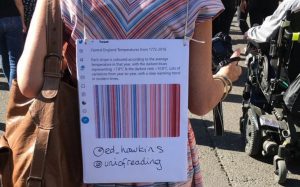Laura Davis, Trust and Foundation Officer at Reading, rocked a custom-made climate stripes dress at the recent climate strike in Oxford.
Laura, who has worked in the Alumni and Supporter Engagement Office since 2015, had the fabric for her fabulous dress custom-printed using the iconic climate stripes graphic created by University of Reading climate scientist, Professor Ed Hawkins. The striking graphic has hit the headlines recently, appearing on the front pages of both The Guardian and The Economist.
Communicating science creatively
To create the fabric, Laura used a company called Spoonflower who use eco-friendly, water-based pigment inks and dyes that produce very little waste. An experienced dressmaker, she then cut, stitched and assembled the dress herself.

Laura was excited to combine her two passions of science and creative design, relishing her role in bringing climate science to life to start important conversations. She praised Professor Hawkins “for giving people the tools to communicate science creatively.”
Laura added: “One of the most exciting things about my job at the University of Reading is the exposure we have to first class, world-leading climate science research.”
She received a hugely positive reaction to her dress from people on the Oxford climate strike on 20 September, as well as on social media. She has plans to create a second dress based on another of Professor Hawkins climate graphics, the climate spirals, that featured in the opening ceremony of the Rio Olympics. Her climate stripes dress also took pride of place on the Extinction Rebellion stand during this year’s Freshers’ Week at Reading.
Climate stripes graphics go viral
The climate stripes plot average temperatures for each year since 1850 and visually demonstrate how temperatures have risen in every corner of the globe. Blue stripes represent cooler temperatures and red stripes represent hotter years. The thick band of deep red stripes that appear on the right-hand side of the graphics act as a stark warning of how human action has contributed to a heating up of the climate over time.
In June 2019, Reading held a week long #madeatreading celebration of its world-class environmental research and action, which culminated in a Show Your Stripes Day to raise awareness of the pervasive reality of global warming. Shareable graphics are available to download for use on social channels, and a striking range of climate stripes clothing was designed and is still available to buy online.
The iconic stripes were downloaded a million times in their first week, and as well as appearing on national newspaper front covers, they have since adorned the main stage at Reading Festival and been featured on TV weather bulletins, a Tesla car and even a German tram.
Professor Hawkins, was awarded the Kavli Medal and Lecture 2018 by The Royal Society for his significant contribution to understanding and quantifying natural climate variability and long-term climate change, and for actively communicating climate science and its various implications to broader audiences:
“I would urge anyone who cares about the future of our planet to check out the stripes for their region and share it with others.
“It’s a powerful way to show what we humans have already done to the climate in our respective home countries. If we want to avoid heating up our homes even further, we must act quickly.”
As Laura attests, when it comes to communicating the impact of climate change; “the climate stripes image is unarguable.”




